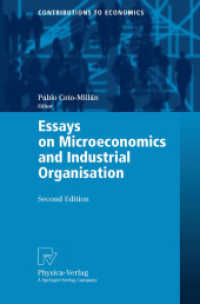Full Description
Highlighting sustainable catalytic processes in synthetic organic chemistry and industry, this useful guide places special emphasis on catalytic reactions carried out at room temperature.
It describes the fundamentals, summarizes key advances, and covers applications in industrial processes in the field of energy generation from renewables, food science, and pollution control. Throughout, the latest research from various disciplines is combined, such as homogeneous and heterogeneous catalysis, biocatalysis, and photocatalysis. The book concludes with a chapter on future trends and energy challenges for the latter half of the 21st century.
With its multidisciplinary approach this is an essential reference for academic and industrial researchers in catalysis science aiming to design more sustainable and energy-efficient processes.
Contents
1 Introduction to Room-Temperature Catalysis 1
Eduardo J. Garcia-Suarez and Anders Riisager
1.1 Introduction 1
1.2 Room-Temperature Homogeneous Catalysts 2
1.2.1 Ionic-Liquid-Based Catalytic Systems at Room Temperature 2
1.2.2 Transition Metal Homogeneous Catalysts 6
1.2.2.1 Group 9-Based Homogeneous Catalysts (Co, Rh, Ir) 6
1.2.2.2 Group 10-Based Homogeneous Catalysts (Ni, Pd, Pt) 7
1.2.2.3 Group 11-Based Homogeneous Catalysts (Ag, Au) 10
1.3 Room-Temperature Heterogeneous Catalysts 10
1.3.1 Group 9-Based Heterogeneous Catalysts (Co, Rh, Ir) 11
1.3.2 Group 10-Based Heterogeneous Catalysts (Ni, Pd, Pt) 13
1.3.3 Group 11-Based Heterogeneous Catalysts (Cu, Pt, Au) 23
1.4 Conclusions and Perspectives 29
References 31
2 Functionalized Ionic Liquid-based Catalytic Systems with Diversified Performance Enhancements 35
Shiguo Zhang and Yanlong Gu
2.1 Introduction 35
2.2 Functionalized ILs for Enhancing Catalytic Activity 36
2.3 Functionalized ILs for Improving Reaction Selectivity 38
2.4 Functionalized ILs for Facilitating Catalyst Recycling and Product Isolation 40
2.5 Functionalized ILs for Making Relay Catalysis 43
2.6 Cation and Anion Synergistic Catalysis in Ionic Liquids 45
2.7 Functionalized ILs for Aqueous Catalysis 46
2.8 Catalysis by Porous Poly-ILs 47
2.9 Functionalized IL-Based Carbon Material for Catalysis 49
2.10 Summary and Conclusions 54
References 54
3 Heterogeneous Room Temperature Catalysis - Nanomaterials 59
Liyu Chen and Yingwei Li
3.1 Introduction 59
3.2 Solid-Acid-Based Nanomaterials 60
3.3 Grafted-Metal-Ions-Based Nanomaterial 65
3.4 Metal NPs-Based Nanomaterial 67
3.4.1 Metal NPs Stabilized by Ligands 67
3.4.2 Metal NPs@Polymers 68
3.4.3 Metal NPs@Metal Oxides 70
3.4.4 Metal NPs@Carbonaceous Support 72
3.4.5 Metal NPs@Siliceous Base Support 74
3.4.6 Metal NPs@MOF Nanocomposites 77
3.5 Metal Oxide NPs-Based Nanomaterial 82
3.6 Summary and Conclusions 83
References 84
4 Biocatalysis at Room Temperature 89
Ivaldo Itabaiana Jr and Rodrigo O. M. A. De Souza
4.1 Introduction 89
4.2 Transaminases 90
4.2.1 General Features 90
4.2.2 Transaminase Applications at Room Temperature 90
4.3 Hydrolases 98
4.3.1 General Features 98
4.3.2 Application of Hydrolases at Room Temperature 100
4.3.2.1 Lipases 100
4.3.2.2 Aldol Additions 101
4.3.2.3 Michael Addition 102
4.3.2.4 Mannich Reaction 102
4.3.2.5 C-Heteroatom and Heteroatom-Heteroatom Bond Formations 103
4.3.2.6 Epoxidation 103
4.3.2.7 Synthesis of Heterocycles 104
4.3.2.8 Kinetic Resolutions 105
4.3.3 Cutinases 107
4.4 Laccases 108
4.4.1 General Features 108
4.4.2 Applications of Laccases 110
4.5 Enzymes in Ionic Liquids 115
4.5.1 General Features 115
References 125
5 Room Temperature Catalysis Enabled by Light 135
Timothy Noël
5.1 Introduction 135
5.2 UV Photochemistry 136
5.3 Visible Light Photoredox Catalysis 139
5.4 Room Temperature Cross-Coupling Enabled by Light 141
5.5 Photochemistry and Microreactor Technology -A Perfect Match? 144
5.6 The Use of Photochemistry in Material Science 146
5.7 Solar Fuels 149
5.8 Conclusion 151
References 151
6 Mechanochemically Enhanced Organic Transformations 155
Davin Tan and Tomislav Frišcic
6.1 Introduction 155
6.2 Mechanochemical Techniques and Mechanisms: Neat versus Liquid-Assisted Grinding (LAG) 156
6.3 Oxidation and Reduction Using Mechanochemistry 160
6.3.1 Direct Oxidation of Organic Substrates Using Oxone 160
6.3.2 Mechanochemical Halogenations Aided by Oxone 162
6.3.3 Reduction Reactions by Mechanochemistry 163
6.4 Electrocyclic Reactions: Equilibrium and Templating in Mechanochemistry 165
6.4.1 The Diels-Alder Reaction: Mechanochemical Equilibrium in Reversible C—C Bond Formation 165
6.4.2 Photochemical [2+2] Cycloaddition during Grinding: Supramolecular Catalysis and Structure Templating 167
6.5 Recent Advances in Metal-CatalyzedMechanochemical Reactions 168
6.5.1 Copper-Catalyzed [2+3] Cycloaddition (Huisgen Coupling) 168
6.5.2 Olefin Metathesis by Ball Milling 169
6.5.3 Mechanochemical C—H Bond Activation 170
6.5.4 Cyclopropanation of Alkenes Using Silver Foil as a Catalyst Source 171
6.6 New Frontiers in Organic Synthesis Enabled by Mechanochemistry 171
6.6.1 Synthesis of Active Pharmaceutical Ingredients (APIs) 172
6.6.2 Reactivity Enabled or Facilitated by Mechanochemistry 173
6.6.3 Trapping Unstable Reaction Intermediates 175
6.7 Conclusion and Outlook 176
Acknowledgments 176
References 176
7 Palladium-Catalyzed Cross-Coupling in Continuous Flow at Room andMild Temperature 183
Christophe Len
7.1 Introduction 183
7.2 Suzuki Cross-Coupling in Continuous Flow 184
7.3 Heck Cross-Coupling in Continuous Flow 192
7.4 Murahashi Cross-Coupling in Continuous Flow 199
7.5 Concluding Remarks 202
References 202
8 Catalysis for Environmental Applications 207
Changseok Han, Endalkachew Sahle-Demessie, Afzal Shah, Saima Nawaz, Latif-ur-Rahman, Niall B.McGuinness, Suresh C. Pillai, Hyeok Choi, Dionysios, D. Dionysiou, andMallikarjuna N. Nadagouda
8.1 Introduction 207
8.2 Ferrate (FeO42-) forWater Treatment 208
8.3 Magnetically Separable Ferrite forWater Treatment 209
8.3.1 Magnetic Nanoparticles 209
8.3.2 Magnetic Recovery of Materials Used forWater Treatment 211
8.3.3 Ferrite Photocatalyst forWater Treatment 212
8.4 UV, Solar, and Visible Light-Activated TiO2 Photocatalysts for Environmental Application 212
8.5 Catalysis for Remediation of Contaminated Groundwater and Soils 215
8.5.1 Catalytic Oxidative Pathways 215
8.5.2 Catalytic Reductive Pathways 217
8.5.3 Prospects and Limitations 218
8.6 Novel Catalysis for Environmental Applications 218
8.6.1 Graphene and Graphene Composites 219
8.6.2 Perovskites and Perovskites Composites 221
8.6.3 Graphitic Carbon Nitride (g-C3N4) and g-C3N4 Composites 222
8.7 Summary and Conclusions 223
Acknowledgments 224
Disclaimer 224
References 224
9 Future Development in Room-Temperature Catalysis and Challenges in the Twenty-first Century 231
Fannie P. Y. Lau, R. Luque, and Frank L. Y. Lam
Case Study 1: Magnetic Pd Catalysts for Benzyl Alcohol Oxidation to Benzaldehyde 237
Yingying Li, Frank L.-Y. Lam, and Xijun Hu
1.1 Introduction 237
1.2 Pd/MagSBA Magnetic Catalyst for Selective Benzyl Alcohol Oxidation to Benzaldehyde 239
1.2.1 Results and Discussion 239
1.2.1.1 Characterization 239
1.2.1.2 Effect of Reaction Temperature 240
1.2.1.3 Effect of Pd Loading 241
1.2.1.4 Recycling Test 246
1.3 Summary and Conclusions 246
References 247
Case Study 2: Development of Hydrothermally Stable Functional Materials for Sustainable Conversion of Biomass to Furan Compounds 251
Amrita Chatterjee, Xijun Hu, and Frank L.-Y. Lam
2.1 Introduction 251
2.2 Metal-Organic-Framework as a Potential Catalyst for Biomass Valorization 254
2.3 Xylose Dehydration to Furfural Using Metal-Organic-Framework, MIL-101(Cr) 255
2.3.1 Xylose Dehydration Catalyzed by Organosilane Coated MIL-101(Cr) 255
2.3.2 Xylose to Furfural Transformation Catalyzed by Fly-Ash and MIL-101(Cr) Composite 258
2.3.3 Xylose to Furfural Transformation Catalyzed by Tin Phosphate and MIL-101(Cr) Composite 262
2.3.4 Role of Acid Sites, Textural Properties and Hydrothermal Stability of Catalyst in Xylose Dehydration Reaction 264
2.4 Conclusion 267
References 268
Index 273







